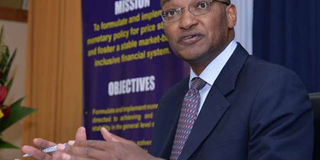Fresh push to bolster banks’ capital base elicits hot debate

Central Bank of Kenya Governor Patrick Njoroge speaks during a media briefing at his office on June 21, 2016. PHOTO | SALATON NJAU | NATION MEDIA GROUP
What you need to know:
- Proponents of retaining current capital limits emphasize the importance of having a diversified financial system that has niche operators to cater for special needs of various market segments.
- Industry observers project that the need for huge capital levels for banks will most likely push them towards going public and getting listed, which puts them on a permanent public spotlight that constantly pushes them towards better management practice.
A second attempt by the government to raise the minimum operating capital for banks from Sh1 billion to Sh5 billion over three years has provoked a contentious debate on exactly how much funds lenders need to be seen to be healthy.
The initial bid in the last financial year came a cropper following doubts expressed by the regulator, Central Bank of Kenya (CBK) and other interested parties including small lenders. The government is likely to finally have its way, following the enactment of the Finance Bill 2016/2017.
The National Treasury Secretary Henry Rotich, who is spearheading the move argues that the latest push is timely based on recent happenings which saw the collapse of two banks and near fall of another lender within months of each other.
“People’s reactions change when they see a problem. Now there is sufficient information to think otherwise and say it’s time we have stronger banks,” Mr Rotich told Bloomberg last week.
Treasury’s road map seeks to have banks increase their core capital to Sh2 billion by the end of 2017, Sh3.5 billion by 2018, and Sh5 billion by the end of 2019.
The plan has, however, sparked debate on whether there is a link between size and safety of lenders and whether big banks are necessarily safer when they possess muscular capital base.
Past arguments in favour of retaining the current capital have observed that the key to stability and strength of banks is not sheer size, but capital adequacy; their ability to have sufficient money to cover all risks that they are taking aboard.
This school of thought calls for a “risk-based” approach in which banks have a strong buffer against losses saying growth for growth’s sake without adequate capital support is recipe for disaster.
They argue that in times of economic turbulence, volatility in markets and the so-called “black swan” (very rare but catastrophic) events such as September 11 or the global financial crisis, a bank with a sound capital base is more likely to stay afloat.
The importance of capital as the anchor in global banking has now been codified in regulatory regimes worldwide, whose spirit is reflected in the so-called Basel II and Basel III rules governing bank capital requirements.
According to recent staff discussion notes (SDNs) by IMF staff members on bank costs and capital, the extent to which institutional improvements (in regulation, supervision, resolution, and governance) can help reduce the required levels of loss absorption is an open question.
The IMF staff in the note argue that any new regulatory minimal requirement should therefore be imposed gradually, when conditions allow, and over a relatively long period of time.
Proponents of the need to substantially raise minimum bank capital levels opine that big is better, that large capitalised banks will in practice tend to attract a wider diversity of both owners and customers, therefore distributing and mitigating concentration risks in ownership and management.
“The first point to note is that we have entered a new normal and that market forces have been unleashed. These market forces are demanding a sufficient capital cushion and are ‘hair-cutting’ [discounting] the numbers as they are being presented,” said Mr Aly Khan Satchu, a Nairobi-based analyst and CEO of Rich Management Ltd.
Mr Khan says there is a place for niche banking. However, he adds, there is no reason that a niche bank should be under capitalised.
Niche banking
“So yes there is also a space for deeper understanding of the various banks models. As we develop this expertise and differentiation, I think we will move towards a more nuanced and sophisticated approach,” said Mr Satchu.
Proponents of retaining current capital limits emphasize the importance of having a diversified financial system that has niche operators to cater for special needs of various market segments.
“Dominant banks will become even more dominant. Large banks are not among the ones playing the best in terms of interest rates and their spreads.
Their business models will be dominant and they will close all small branches out there, resulting in a reversal of financial inclusion that we have been pushing for,” CBK governor Dr Patrick Njoroge told the National Assembly in August last year when appeared before the House Finance, Planning and Trade committee.
This argument has been challenged on the grounds that despite its idealistic intention, small banks in Kenya have largely been structured along exclusive enclaves of family, race or faith, none of which offer a conducive environment or incentive for professional decision-making.
The case for niche banking, observers say, should be thematic rather than the current identity-driven models, intended to fill-up funding gaps in select areas such as agriculture, industry and affordable housing.
Industry observers project that the need for huge capital levels for banks will most likely push them towards going public and getting listed, which puts them on a permanent public spotlight that constantly pushes them towards better management practice.
Conversely, small banks will in practice tend to suffer concentration of ownership, management and client base that breed insider relationships that do not encourage professional decision-making.
Mr Rotich who has made suggestions that Kenya is overbanked has often used the Nigerian scenario to back Treasury’s position.
He has argued that a similar scenario to that of Kenya existed in the Nigerian banking scene prior to the entry of Mr Lamido Sanusi, where disregard for prudential lending, imprudent insider lending, capital flight were widespread.
Analysts say Mr Sanusi’s drastic interventions beginning with the raising of minimum capital for banks to Sh25 billion alongside other regulatory measures created the basis for the current vibrancy of Nigerian banks.
The case for large capitalised banks has also been supported in some quarters by the funding gaps that are so prominent in the Kenyan economy, notably the infrastructure deficits from the lack of funding capacity, partly attributed to inability of Kenyan banks to fund them.
The current dependence on foreign DFIs — which are indeed foreign-owned banks — implies local banks have left a gap for them to fill.





